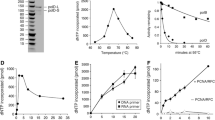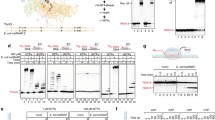Summary
The Escherichia coli polB gene encodes DNA polymerase II and is regulated by the SOS system. We sequenced a 4081 nucleotide segment of the E. coli chromosome that contains the polB gene and its flanking regions. DNA polymerase II, as deduced from the DNA sequence, consists of 782 amino acids, has a molecular weight of 89917, and is structurally homologous to α-like DNA polymerases, which include eukaryotic replicative DNA polymerases. Comparison of the sequences of the α-like DNA polymerases including E. coli DNA polymerase II showed that there were nine highly conserved regions, and we constructed an unrooted phylogenetic tree of the DNA polymerases based on the differences in these conserved regions. The DNA polymerases of herpes groups viruses and the DNA polymerases that use protein priming for the initiation of replication form two separate subfamilies that occupy opposite locations in the tree. Other DNA polymerases, including E. coli DNA polymerase II, human DNA polymerase α, and yeast DNA polymerase I, occupy the central regions between the two subfamilies and they are rather distantly related to each other. The transcription initiation site of polB was identified by analysis of in vivo transcripts, and the promoter was assigned upstream of the polB coding region. The recognition sequence of the LexA repressor (SOS box) was identified by a footprinting experiment. It overlaps the −35 sequence of the polB promoter.
Similar content being viewed by others
References
Argos P (1988) A sequence motif in many polymerases. Nucleic Acids Res 16:9909–9916
Argos P, Tucker AD, Philipson L (1986) Primary structural relationships may reflect similar DNA replication strategies. Virology 149:208–216
Bachmann BJ (1972) Pedigrees of some mutant strains of Escherichia coli K-12. Bacteriol Rev 36:525–557
Baer R, Bankier AT, Biggin MD, Deininger PL, Farrell PJ, Gibson TJ, Hatfull G, Hudson GS, Satchwell SC, Séguin C, Tuffnell PS, Barrell BG (1984) DNA sequence and expression of the B95-8 Epstein-Barr virus genome. Nature 310:207–211
Bernad A, Zaballos A, Salas M, Blanco L (1987) Structural and functional relationships between prokaryotic and eukaryotic DNA polymerases. EMBO J 6:4219–4225
Bernad A, Blanco L, Lázaro JM, Martin G, Salas M (1989) A conserved 3′→5′ exonuclease active site in prokaryotic and eukaryotic DNA polymerases. Cell 59:219–228
Bernad A, Lázaro JM, Salas M, Blanco L (1990) The highly conserved amino acid sequence motif Tyr-Gly-Asp-Thr-Asp-Ser in a-like DNA polymerases is required by phage Φ29 DNA polymerase for protein-primed initiation and polymerization. Proc Natl Acad Sci USA 87:4610–4614
Binns MM, Stenzler L, Tomley FM, Campbell J, Boursnell MEG (1987) Identification by a random sequencing strategy of the fowlpoxvirus DNA polymerase gene, its nucleotide sequence and comparison with other viral DNA polymerases. Nucleic Acids Res 15:6563–6573
Bonner CA, Randall SK, Rayssiguier C, Radman M, Eritja R, Kaplan BE, McEntee K, Goodman MF (1988) Purification and characterization of an inducible Escherichia coli DNA polymerase capable of insertion and bypass at abasic lesions in DNA. J Biol Chem 263:18946–18952
Boulet A, Simon M, Faye G, Bauer GA, Burgers PMJ (1989) Structure and function of the Saccharomyces cerevisiae CDC2 gene encoding the large subunit of DNA polymerase III. EMBO J 8:1849–1854
Brent R, Ptashne M (1981) Mechanism of action of the lexA gene product. Proc Natl Acad Sci USA 78:4204–4208
Campbell JL, Soll L, Richardson CC (1972) Isolation and partial characterization of a mutant Escherichia coli deficient in DNA polymerase II. Proc Natl Acad Sci USA 69:2090–2094
Chen H, Bryan SK, Moses RE (1989) Cloning the polB gene of Escherichia coli and identification of its product. J Biol Chem 264:20591–20595
Davison AJ, Scott JE (1986) The complete DNA sequence of varicella-zoster virus. J Gen Virol 67:1759–1816
Dekker BMM, van Ormondt H (1984) The nucleotide sequence of fragment HindIII-C of human adenovirus type 5 DNA (map positions 17.1–31.7). Gene 27:115–120
Derbyshire V, Freemont PS, Sanderson MR, Beese L, Friedman JM, Joyce CM, Steitz TA (1988) Genetic and crystallographic studies of the 3′,5′-exonucleolytic site of DNA polymerase I. Science 240:199–201
Earl PL, Jones EV, Moss B (1986) Homology between DNA polymerases of poxviruses, herpesviruses, and adenoviruses: nucleotide sequene of the vaccinia virus DNA polymerase gene. Proc Natl Acad Sci USA 83:3659–3663
Ebina Y, Takahara Y, Kishi F, Nakazawa A (1983) LexA protein is a repressor of the colicin E1 gene. J Biol Chem 258:13258–13261
Engler JA, Hoppe MS, van Bree MP (1983) The nucleotide sequence of the genes encoded in early region 2b of human adenovirus type 7. Gene 21:145–159
Freemont PS, Friedman JM, Beese LS, Sanderson MR, Steitz TA (1988) Cocrystal structure of an editing complex of Klenow fragment with DNA. Proc Natl Acad Sci USA 85:8924–8928
Gibbs JS, Chiou HC, Bastow KF, Cheng Y-C, Coen DM (1988) Identification of amino acids in herpes simplex virus DNA polymerase involved in substrate and drug recognition. Proc Natl Acad Sci USA 85:6672–6676
Gibbs JS, Chien HC, Hall JD, Mount DW, Retondo MJ, Weller SK, Coen DM (1985) Sequence and mapping analyses of the herpes simplex virus DNA polymerase gene predict a C-terminal substrate binding domain. Proc Natl Acad Sci USA 82:7969–7973
Gingeras TR, Sciaky D, Gelinas RE, Bing-Dong J, Yen CE, Kelly MM, Bullock PA, Parsons BL, O'Neill KE, Roberts RJ (1982) Nucleotide sequence from the adenovirus-2 genome. J Biol Chem 257:13475–13491
Gross J, Gross M (1969) Genetic analysis of an E. coli strain with a mutation affecting DNA polymerase. Nature 224:1166–1168
Henikoff S (1984) Unidirectional digestion with exonuclease III creates targeted breakpoints for DNA sequencing. Gene 28:351–359
Hirota Y, Gefter M, Mindich L (1972) A mutant of Escherichia coli defective in DNA polymerase II activity. Proc Natl Acad Sci USA 69:3238–3242
Hood LE, Wilson JH, Wood WE (1975) Molecular biology of eucaryotic cells: a problems approach. W.A. Benjamin, Menlo Park, California
Huberman JA (1981) New views of the biochemistry of eucaryotic DNA replication revealed by aphidicolin, an unusual inhibitor of DNA polymerase α. Cell 23:647–648
Inokuchi Y, Hirashima A (1987) Interference with viral infection by defective RNA replicase. J Virol 61:3946–3949
Iwasaki H, Nakata A, Walker GC, Shinagawa H (1990) The Escherichia coli polB gene, which encodes DNA polymerase II, is regulated by the SOS system. J Bacteriol 172:6268–6273
Joyce CM, Grindley NDF (1984) Method for determining whether a gene of Escherichia coli is essential: application to the polA gene. J Bacteriol 158:636–643
Joyce CM, Kelley WS, Grindley NDF (1982) Nucleotide sequence of the Escherichia coli polA gene and primary structure of DNA polymerase I. J Biol Chem 257:1958–1964
Jung G, Leavitt MC, Hsieh J-C, Ito J (1987) Bacteriophage PRD1 DNA polymerase: evolution of DNA polymerases. Proc Natl Acad Sci USA 84:8287–8291
Kempken F, Meinhardt F, Esser K (1989) In organello replication and viral affinity of linear, extrachromosomal DNA of the ascomycete Ascobolus immersus. Mol Gen Genet 218:523–530
Kenyon CJ, Walker GC (1980) DNA-damaging agents stimulate gene expression at specific loci in Escherichia coli. Proc Natl Acad Sci USA 77:2819–2823
Kornberg A (1980) DNA replication. W.H. Freeman and Co., San Francisco
Kouzarides T, Bankier AT, Satchwell SC, Weston K, Tomlinson P, Barrell BG (1987) Sequence and transcription analysis of the human cytomegalovirus DNA polymerase gene. J Virol 61:125–133
Larder BA, Kemp SD, Darby G (1987) Related functional domains in virus DNA polymerases. EMBO 16:169–175
Lawyer FC, Stoffel S, Saiki RK, Myambo K, Drummond R, Gelfand DH (1989) Isolation, characterization, and expression in Escherichia coli of the DNA polymerase gene from Thermus aquaticus. J Biol Chem 264:6427–6437
Leavitt MC, Ito J (1989) T5 DNA polymerase: structural-functional relationships to other DNA polymerases. Proc Natl Acad Sci USA 86:4465–4469
Lee N, Gielow W, Martin R, Hamilton E, Fowler A (1986) The organization of the araBAD operon of Escherichia coli. Gene 47:231–244
Lopez P, Martinez S, Diaz A, Espinosa M, Lacks SA (1989) Characterization of the polA gene of Streptococcus pneumoniae and comparison of the DNA polymerase I it encodes to homologous enzymes from Escherichia coli an phage T7. J Biol Chem 264:4255–4263
Maniatis T, Fritsch EF, Sambrook J (1982) Molecular cloning: a laboratory manual. Cold Spring Harbor Laboratory Press, Cold Spring Harbor, New York
McHenry CS (1988) DNA polymerase III hotoenzyme of Escherichia coli. Annu Rev Biochem 57:519–550
Morrison A, Christensen RB, Alley J, Beck AK, Bernstine EG, Lemontt JF, Lawrence CW (1989) REV3, a Saccharomyces cerevisiae gene whose function is required for induced mutagenesis, is predicted to encode a nonessential DNA polymerase. J Bacteriol 171:5659–5667
Nishikawa K, Nakashima H, Kanehisa M, Ooi T (1987) Detection of weak sequence homology of proteins for tertiary structure prediction. Protein Seq Data Anal 1:107–116
Ollis DL, Brick P, Hamlin R, Xuong NG, Steitz TA (1985a) Structure of large fragment of Escherichia coli DNA polymerase I complexed with dTMP. Nature 313:762–766
Ollis DL, Kline C, Steitz TA (1985b) Domain of E. coli DNA polymerase I showing sequence homology to T7 DNA polymerase. Nature 313:818–819
Paillard M, Sederoff RR, Levings CS III (1985) Nucleotide sequence of the S-1 mitochondrial DNA from the S cytoplasm of maize. EMBO J 4:1125–1128
Pizzagalli A, Valsasnini P, Plevani P, Lucchini G (1988) DNA polymerse I gene of Saccharomyces cerevisiae: nucleotide sequence, mapping of a temperature-sensitive mutation, and protein homology with other DNA polymerases. Proc Natl Acad Sci USA 85:3772–3776
Saitou N, Nei M (1987) The neighbor-joining method: a new method for reconstructing phylogenetic trees. Mol Biol Evol 4:406–425
Sakaguchi K (1990) Invertrons, a class of structurally and functionally related genetic elements that includes linear DNA plasmids, transposable elements, and genomes of adeno-type viruses. Microbiol Rev 54:66–74
Sanger F, Nicklen S, Coulson AR (1977) DNA sequencing with chain-terminating inhibitors. Proc Natl Acad Sci USA 74:5463–5467
Seto A, Ihara S, Kohtsuki S, Ooi T, Sakakibara S (1988) Peptide and protein databanks in Japan. In: Lesk AM (ed) Computational molecular biology. Oxford University Press, Oxford, pp 27–37
Shu L, Hong JS, Wei Y-F, Engler JA (1986) Nucleotide sequence of the genes encoded in early region 2b of human adenovirus type 12. Gene 46:187–195
Spicer EK, Rush J, Fung C, Reha-Krantz LJ, Karam JD, Konigsberg WH (1988) Primary structure of T4 DNA polymerase: evolutionary relatedness to eucaryotic and other procaryotic DNA polymerases. J Biol Chem 263:7478–7486
Stark MJR, Mileham AJ, Romanos MA, Boyd A (1984) Nucleotide sequence and transcription analysis of a linear DNA plasmid associated with the killer character of the yeast Kluyveromyces lactis. Nucleic Acids Res 12:6011–6030
Tomalski MD, Wu J, Miller LK (1988) The location, sequence, transcription, and regulation of a baculovirus DNA polymerase gene. Virology 167:591–600
Tomasiewicz HG, McHenry CS (1987) Sequence analysis of the Escherichia coli dnaE gene. J Bacteriol 169:5735–5744
Treisman R, Proudfoot NJ, Shander M, Maniatis T (1982) A single-base change at a splice site in a β0-thalassemic gene causes abnormal RNA splicing. Cell 29:903–911
Tsurumi T, Maeno K, Nishiyama Y (1987) Nucleotide sequence of the DNA polymerase gene of herpes simplex virus type 2 and comparison with the type 1 counterpart. Gene 52:129–137
Vieira J, Messing J (1987) Production of single-stranded plasmid DNA. Methods Enzymol 153:3–11
Wertman KF, Mount DW (1985) Nucleotide sequence binding specificity of the LexA repressor of Escherichia coli K-12. J Bacteriol 163:376–384
Wong SW, Wahl AF, Yuan P-M, Arai N, Pearson BE, Arai K, Korn D, Hunkapiller MW, Wang TS-F (1988) Human DNA polymerase a gene expression is cell proliferation dependent and its primary structure is similar to both prokaryotic and eukaryotic replicative DNA polymerases. EMBO J 7:37–47
Yanisch-Perron C, Vieira J, Messing J (1985) Improved M13 phage cloning vectors and host strains: nucleotide sequences of the M13mp18 and pUC19 vectors. Gene 33:103–119
Yoshikawa H, Ito J (1982) Nucleotide sequence of the major early region of bacteriophage Φ29. Gene 17:322–335
Author information
Authors and Affiliations
Additional information
Communicated by M. Sekiguchi
Rights and permissions
About this article
Cite this article
Iwasaki, H., Ishino, Y., Toh, H. et al. Escherichia coli DNA polymerase II is homologous to α-like DNA polymerases. Mol Gen Genet 226, 24–33 (1991). https://doi.org/10.1007/BF00273583
Issue Date:
DOI: https://doi.org/10.1007/BF00273583




